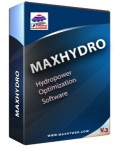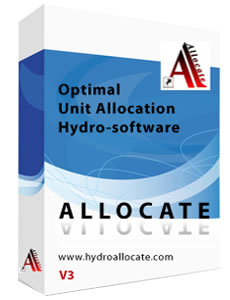Hydropower Optimization Software
HYDRO / WATER
Hydro stands for Water, in the context of our website, it is the water in the rivers and lakes, which has a value.
Theoretically the highest value of a unit volume of water would be at the top of the mount Everest.
The value of the water as power source would be zero at sea level.
MATHEMATICAL FORMULATIONS
g is the gravity constant 9.81 and Eff is the efficiency of the machinery which produces the Power or the Energy. Efficiency varies, but we can assume for our demo here to be constant of 0.85
For example if we have flow of 100 m3/sec and if we assume that we can drop that water from a height of 100 m then the power will be:
P = 9.81 x 0.85 x 100 x 100
P = 83,385 kW (kilo Watts) or 83.385 mW (mega Watts)
The next question to answer is how much energy we can produce with the above power?
If we assume that the power of 83.385 mW will be available 24 hours then the total energy E in kWh (kilo Watts hours) or mWh (mega Watts hours) will be:
E = 83.385 x 24 = 2,001.24 mWh or 2,001,240.00 kWh sometimes when we have bigger quantities of energy we use gWh (giga Watts hours) i.e. the above kWh divided by 1,000,000:
E = 2.001 gWh
This energy will be enough to power 200,000 households or roughly a city of 800,000 people for 24 hour.
It is amazing the power of the water isn't it? Only an avearge river with 100 m head to give us all that power.
THE WATERY CYCLE
The Hydropower is renewed by the power of the sun and the water in the oceans.
The sun heats the earth(oceans) and creates evaporation, the evaporated water is lifted in the air by the winds, then clouds are formed. The winds move the clouds all around the the earth.
Finally "what goes up must come down" the water fail on the earth as rain.
It is raining almost everywhere in the world, but the rain that falls at a higher elevation will have bigger potential power relative to the sea level.
Wherever the rain falls, it starts flowing down the rivers toward the sea. During this journey, it loses its potential power and when it reaches the sea the potential power will be zero.
After this, the cycle starts all over again, it never stops.

HYDROPOWER / WATERPOWER
In very simple terms the Hydropower or the Waterpower is the potential power or potential energy of the water at certain level above the sea level.
The higher the water is above the sea, the higher is the potential power. Because water is liquid due to the earth gravity will flow toward the lover elevations in rivers.
As the water flows toward the sea it loses its potential power and at sea level the potential power is zero.
The power of water has been utilized in different forms for millenniums but only in the last 200 years, with the inventions of the electrical generators, the mechanical (kinetic) energy generated by the power of the water is converted to electrical energy.
Mathematically the power is product of the water flow and the head difference; to utilize the hydropower, head differences must be created in a river.
In some rivers naturally created head differences are already created, those are the waterfalls.
- River diversions, channels or tunnels
- River barriers and dams
The created head and the water flow can be used to turn the turbines of the hydroelectric plant and produce electricity; the used water is released into its river bed downstream of the plant.
The river barrier and dams are structures that are constructed across the river bed. They basically immediately stop the river flow and create head difference like channel of 0% slope.
There is always a small or bigger lake formed behind the barrier or the dam.
The head difference is the level of the lake and the river bed on the other side of the barrier or the dam.
This head difference and the water from the lake are used to produce kinetic energy and turn the hydro turbines that are connected to electric generators which ultimately produce electrical energy.

RESERVOIR
The reservoir that is created after the Dam is build is the most important element of the Hydropower.
The reservoir creates water storage and in terms of Hydropower, creates storage of potential power. The potential power increases with the increase of the water elevation in the reservoir.
The world at present does not have technology to store huge amount of electrical power, there is some small power stored in batteries but that is negligible.
Because of the nature of the hydropower that can be produced almost instantly, practically we can assume that the stored potential power in the reservoir is stored electrical power.
The importance of this reserved electrical power is crucial for maintaining the stability of the electrical power grids across the world.
OPERATION - HYDROPOWER PLANT - RESERVOIR
1, the reservoir is at certain level
If there is no reservoir into consideration, then the operation of the power plant should be simple, the operators should only be looking at loading the generating units in an optimal way i.e. produce maximum power with the available inflow or produce the power with maximum efficiency.
There could be several ways to produce the power but it is essential that the power is always produced with minimum amount of water, meaning that the power is generated with maximum efficiency.
As we can see from this simplified example the task in front of the power system operators is very difficult. The operators in the past relied on experience and charts and tables based on historical data. But at present the most operators rely on some kind of software solution that present the operators a optimal or near optimal solution.
There are several techniques that are used to help the hydropower plant operators in their daily decision making processes. Those techniques are either based on simulation or optimization. The simulation techniques are simpler to use but not always accurate to a required degree. The optimization techniques are more complex but could provide more accurate results that may lead in some cases to significant improvements in the operation of the hydropower systems, which ultimately result in significant monetary benefits.
OPTIMIZATION
Hydropower is non-linear function though the operation problems in hydropower are non-linear problems.
The best solution to non-linear problems can be obtained by application of non-linear optimization techniques.
Most suited optimization technique at the present is the Dynamic Programming.
Dynamic programming is an optimization approach that transforms a complex problem into a sequence of simpler problems.
Its essential characteristic is the multistage nature of the optimization procedure. More so than the optimization techniques described previously, dynamic programming provides a general framework for analyzing hydropower optimization problems.
Usually creativity and intuition and inside deep knowledge of the reservoir and hydropower plant is required to formulate and successfully solve hydropower optimization problems.
MaxHydro is a set of interlinked computer programs that can be used as a decision support tool for hydropower system planning, analysis and operation. Using a mathematical model of a hydropower system, the programs provide an optimal or best-fit solution to the operational dilemmas faced by hydropower system operators. Use of the program can result in significant improvements to daily energy production or revenues. It is an optimization program because it is based on mathematical formulation of the hydropower system and provides an optimal solution to the problem depending on the selected objective function taking into account numerous constraints.
Allocate is a Windows based program designed to optimize the hydropower station efficiency by allocating the power load to each generating unit such that the total station outflow is equal to a given discharge and the total station power is maximized.
Allocate is based on Dynamic Programming (DP) formulation. It uses a unique algorithm to derive the optimum load allocation among the available generating units. ALLOCATE accepts different type and size of generating units and either common or separate conduits.
Our Clients
Pricing
MaxHydro 4.1
- — single user
- — email support
- — remote zoom support
Allocate 3.5
- — single user
- — email support
- — remote zoom support
Try or Use it, fully functional version (MaxHydro 4.1) for 1 Month
- — single user, email support
- — remote zoom support
- — trouble shooting











